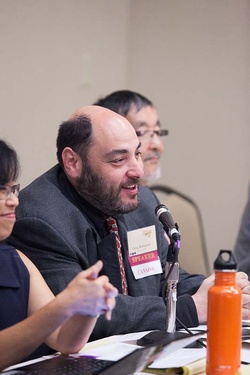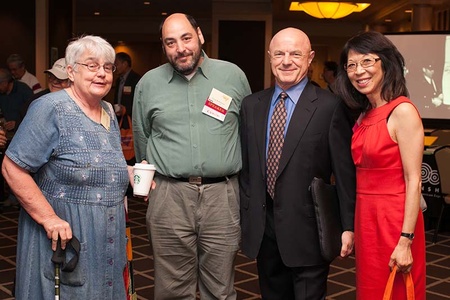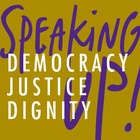I was privileged to attend the 2013 Japanese American National Museum conference in Seattle. It commemorated the 25th anniversary of the Civil Liberties Act of 1988, granting surviving Japanese Americans redress for their wartime confinement. The conference was a concentrated and rather intense experience, for a number of reasons.
I arrived at the conference on Friday, July 5. Sadly, I missed out on the morning planning session for Tule Lake, which I heard afterwards had been quite a lively session. Once I was registered, I went around the hall greeting people I knew and being introduced to others.
The first actual conference event, on Friday afternoon, was the opening plenary session. The opening act was a wonderfully acrobatic Taiko performance by Seattle Kokon Taiko, followed by a statement by the acting Japanese consul in Seattle. Dr. Mitch Maki of Cal State Dominguez Hills officiated. He thanked the sponsors, and gracefully spoke about the importance of the conference, about the continuing importance of speaking out about the wartime Japanese American experience. He was both eloquent and funny.

Seattle Kokon Taiko at the opening general session on Friday, July 5. (Photo courtesy of Tracy Kumono Photography)
Tom Ikeda of DENSHO then gave an excellent speech about branching out past exclusively JA concerns, as well as protecting the memories of the camps. In the process, he showed excerpts from a video interview he had done with the late Gordon Hirabayashi several years ago. Tom cracked me up when he quoted a comment by the distinguished historian Roger Daniels to the effect that Seattle Nikkei are innovators and have original ideas—but that Los Angeles Nikkei think they are the center of the world and pay them no attention!
There was also an interesting speech by Mike Lowry, the former Washington State governor who during his time in Congress was an early and important supporter of redress. I thought that Dr. Greg Kimura, the President and CEO of JANM, was particularly effective in his remarks. Greg started his speech with his memories of growing up in Alaska and going down to Seattle for all the Japanese foods and cultural events that he could not get at home.
After the opening, I was not able to attend the panel sessions. Instead, I was grabbed by a documentary filmmaker, Claudia Katayanagi, and was lured to her room—quite innocently, as it turned out, as she wanted to film me for a documentary she is putting together about the WRA’s isolation center at Leupp, Arizona (a former Indian school where various inmate “troublemakers” from Manzanar and elsewhere were sent). I had only limited knowledge of Leupp (though at least I know that it is pronounced “loop”!), so I spoke mostly about the larger comparisons between the wartime treatment of Japanese Americans and Japanese Canadians.
By the time I finished, it was time for a rehearsal for the following day’s closing session, at which we were booked to do “Ignite” presentations. These are 5-minute talks accompanying a set of 20 slides on the big screen—a quite demanding format! I did get to say hello to my fellow panelists Professor Masako Iino, past president of Tsuda College, and Dr. Sybil Jordan Hampton, retired president of the Winthrop Rockefeller Foundation in Arkansas.
After the rehearsal, I went to a get-together for Discover Nikkei authors. There I saw Dr. Arthur Hansen, who is a consultant for the Museum. I am very fond of Art, who is a pioneering Asian American Studies scholar. I know that he did a great deal of work in putting together the conference program, but he modestly disclaimed credit. I also got to meet Alan Nishio. I pumped him for stories of his (unsuccessful) maverick campaign for National Director of the JACL in the early 1970s, which shook that said organization up! I also spoke briefly to the filmmaker Janice Tanaka, and was pleased to tell her that I had just cited in one of my Nichi Bei Weekly columns her powerful documentary When You’re Smiling, about the deadly long-term impact of incarceration on postwar Nisei and Sansei.

From left to right: Heng Wee Tan, Greg Robinson, and Vicky Murakami-Tsuda at the Discover Nikkei Meet-up (Photo courtesy of Tracy Kumono Photography)
After hanging out at the Discover Nikkei event, I went out to dinner with friends at the sushi restaurant Shiro’s, which has some of the finest sushi I have eaten in North America, then went back and hung out in my room and ate magnificent cherries from Pike Place Market. Whether it was the tea at dinner or the excitement of the day, I had a near sleepless night after that, and honesty compels me to confess that I slept in and thus missed the Saturday morning plenary session.
I am told that Alan Nishio gave a fine talk and that Judge Mary Schroeder, who wrote the opinion for the 9th Circuit in the Gordon Hirabayashi coram nobis case during the 1980s, was very effective as well. I am told that Judge Schroeder mentioned that when Hirabayashi was in court, the sunlight from the windows hit him where he was sitting, and bathed him in light like a halo, which seemed like a fine omen for his case!
At any rate, after the morning session were several panel sessions (very frustratingly, I was on one of them at the same time as several other panels I would have loved to attend, including one on Japanese Canadians!). My panel was on Japanese Americans and the civil rights movement. The room was packed—in gratifying contrast, I must say, to most professional conferences I have attended, where a crowd of 25 people for a panel, especially first thing in the morning, is considered a success!

At Nikkei Activism and the Civil Rights Movement session. (Photo courtesy of Tracy Kumono Photography)
Professor Daryl Joji Maeda of University of Colorado moderated. I spoke first, about the Japanese American redress movement as an outgrowth of the civil rights movement and the reactions of Black Americans. I pointed out that African American political leaders such as the late California Congressman Mervyn Dymally had been the most important early supporters of reparations for former inmates. Professor Diane Fujino of UC Santa Barbara then spoke more generally about postwar interracial activism by Nisei and Sansei such as Richard Aoki and Yuri Kochiyama. After that, the Japanese Canadian photographer Tamio Wakayama gave a presentation about his experiences during the civil rights movement as a photographer for the Student Nonviolent Coordinating Committee. While he spoke, selections of his photos played on the screen (Tamio’s partner Mayu Takasaki staffed the AV). Tamio was both so vivid and hilarious in his tales that he quite stole the show.
After the panel, I spoke with Diane about civil rights and postwar Nisei politics—a subject of great interest to me and a chief subject of my latest book After Camp. I also got to see Lloyd Inui, whom I greatly respect as both a kind human being and a pioneer Asian American Studies figure—Lloyd was largely responsible for building the program at Cal State Long Beach. In recent years Lloyd has worked together with Art Hansen, advising on programs for JANM.
Soon it was time for lunch. The keynote speech was by my friend Eric Yamamoto, Professor of Law at University of Hawaii. Eric has been a renowned advocate for healing through justice all over the world, whether through his work to promote reparations for Japanese Americans, in defending the right to health care for displaced Pacific Islanders, or seeking redress for wartime Korean “comfort women” used as sex slaves. Most recently he has worked to publicize the 1948 massacres by the South Korean government on the island of Daeju—atrocities that occurred during the period of postwar US occupation and with US complicity.
Eric’s speech illustrated how Japanese American redress served as a beacon for the rest of the world in presenting a successful example of people who brought their government to account and forced its leaders to make reparation for crimes against them. He then demonstrated clearly how all these other examples connected to Japanese American redress, and concluded that the struggle for redress would remained unfinished until Japanese Americans could draw from their experience to support others. Eric so clearly and cogently indicated the direction in which Japanese Americans communities could build from their experience that I feel his speech was the highlight of the conference.
After lunch, I chaired a panel on wartime Japanese American experience outside the West Coast. Once again, the room was packed with listeners. Professor Eiichiro Azuma of University of Pennsylvania spoke about the Nikkei in wartime Japan. He made a forceful case that they have been unjustly excluded from the Japanese American story. Dr. Franklin Odo, late of the Smithsonian Institution, spoke briefly about the wartime experience of Japanese Americans in his native Hawaii. Dr. Odo noted that recent historians had not paid enough attention to martial law and its impact on wartime Hawaii—since I wrote a long chapter on the question in my book A Tragedy of Democracy, I warmly endorse the idea that more needs to be done. Grace Shimizu of the Campaign for Justice followed with an overview of the wartime kidnapping of the Latin American Japanese, their internment in the United States, and their struggle for redress.
There were a few fireworks during the Q&A session. When Eiichiro was asked how the Nikkei in Japan might be added to the history of Japanese Americans, he remarked that the stories of many different groups—Shin Issei, Latin American Japanese, and others—tended to be left out of the narrative of what was “Japanese American”, which made people angry. He added that because he came from Japan, he himself was sometimes not considered Japanese American, and added, “So I get to be angry, too!”, a comment that broke the audience up with laughter.
I ran from that session to the closing session, which took place in the large ballroom. It consisted of “Ignite” presentations with slide shows. There were speeches by five panelists, plus a Q&A directed by Irene Hirano Inouye. Lane Maki, Mitch Maki’s daughter, spoke about her daily life and her friends, and concluded with her wish to live in a world where she would not be constantly reminded of her Japanese ancestry but where she could still embrace it. Craig Ishii, executive director of the youth group Kizuna, spoke of the challenges in building a new generation of community leaders. Masako Iino related what the Japanese have learned from the story of Japanese Americans, and how it has helped them to cope with the challenges posed by an increasingly diverse population in Japan. Dr. Sybil Jordan Hampton described her own experience as a young Black girl integrating Little Rock’s Central High School in the 1950s, and spoke eloquently about the need for people from different groups to come together in defense of equal rights.
My own presentation was on the rights of LGBT Americans, especially Japanese Americans. When I mentioned the Supreme Court’s recent action in overturning DOMA, there was a spontaneous burst of applause, which equally surprised and gratified me. There were several questions from the audience afterward about how Nikkei today could keep up the legacy of the Japanese American experience. I suggested supporting community institutions and media such as Nichi Bei Weekly (as a columnist, I gave it pride of place), JANM, Rafu Shimpo, Pacific Citizen, and Discover Nikkei—I should also have mentioned Seattle-based institutions such as the North American Post, International Examiner, and DENSHO.
We had a break after the final session, then came together for a banquet and some final presentations. U.S. Senator Mazie Hirono of Hawaii sent videotaped greetings, in which she spoke of her own story as a postwar Japanese immigrant raised by a single mother (one anecdote she recounted broke up the audience: when she was describing in a speech or press conference all of the ways in which she was an outsider, as a woman, immigrant, Buddhist, Asian American, and child of a single mother, she was asked “And are you Gay, too?” to which she replied jokingly, “Well, nobody’s perfect!”).
There was a performance of a song from the upcoming musical Allegiance, and a speech by the ageless Norman Mineta, who has so long carried the legacy of the camp experience into the halls of power. (The late Senator Daniel Inouye, who had meant to attend before his passing, was honored by a video tribute). Finally, Gordon Yamate of the JANM Board took the podium to send warm wishes to the crowd, and Dr. Greg Kimura then did the final farewell.
I have spoken to many people who found the conference as a whole very inspiring. The overall question asked throughout the proceedings was “What future is there for Japanese Americans and their historical legacy?”, which indeed seems to me a crucial one. I think that by the choice of topics for panel presentations, the inclusion of Japanese and Canadian scholars, and the effort to bring in younger speakers, the people at JANM demonstrated a welcome spirit of openness.
It must also be said that, as a non-Japanese, I was especially pleased by the sense of acceptance that I felt from everyone at the conference. I was no longer a foreigner, nor even an honored guest, just an accepted member of the community. My friend Dr. Linda Tamura expressed this most wittily (and touchingly) when she said “Greg, you’ve become part Japanese by now!” Even more, it gives me hope for the community’s ability to live up to and make newly relevant the legacy of wartime incarceration, even after the last survivor of the camps has passed on.
© 2013 Greg Robinson








